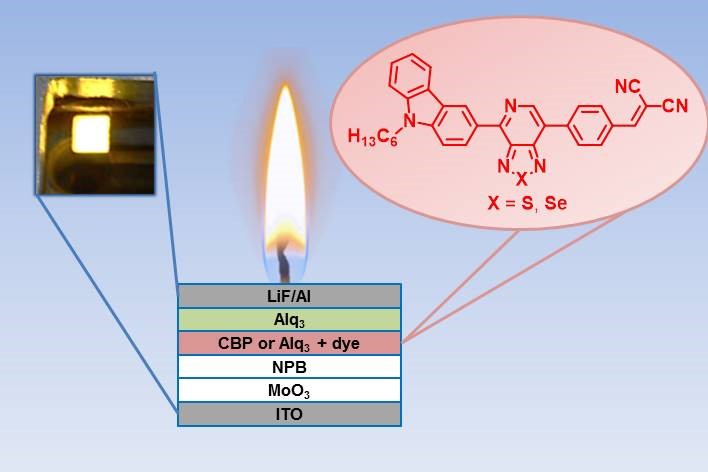Natural sunlight is the main component required for supporting life in plants, animals and people on Earth. To replace natural light, people are successfully using artificial light sources functioning on burning various fuels, or on electricity. Scientists from South Ural State University, jointly with their colleagues from Moscow, have created innovative and safe light-emitting-diode devices. The article about this development was published in one of the most prestigious first-quartile journals, Chemical Communications.
Good Light for Good Mood
Solar irradiation is characterized with the best quality of light, perfectly suitable for sustaining life of humans and other living creatures, but it cannot be used for lighting at nighttime. Researchers consider that the safest natural light substitute for human body is the light from burning candles, the emission spectrum of which is similar to the solar spectrum at sunrise or sunset, and that is why it is thought to be quite adjusted to physiology. Within their work under grant 15-13-10022 from the Russian Science Foundation, the staff members of the joint laboratory of South Ural State University and the Institute of Organic Chemistry of the Russian Academy of Sciences, in collaboration with scientists from the Lebedev Physical Institute of the Russian Academy of Sciences and D. Mendeleev University of Chemical Technology of Russia managed to create a physiologically safe light-emitting diode based on a hybrid of organic and metalloorganic emissive materials, which features luminous characteristics similar to those of candle flame.
“At present, incandescent lamps with their continuous spectrum, because of their low cost-effectiveness and short service life are being ubiquitously replaced with light-emitting and gas-discharge sources; however, the irradiation from these new sources of light is extremely rich in indigo emission, and that is hazardous for human eye and can cause physiological disorders in body,” shares the work supervisor Oleg Rakitin, Doctor of Sciences (Chemistry), Professor.
A well-known problem caused by indigo emission is a significant decrease in the melatonin concentration in human body. Melatonin is a hormone that regulates the sleep-wake cycles (body’s circadian cycles or day-night rhythms), and it is generated right before you fall asleep.
“It has been proven that maintaining the optimal level of melatonin can prevent and even cure certain types of cancer (breast cancer, prostate cancer, and colon cancer), the risks of which are higher with aging; and circadian dysregulation can cause the disturbance of balance in regular metabolism in general,” explains Oleg Rakitin.
In addition we should not underestimate the psychophysiological effect of the light from sources with unbalanced and line spectrum: such light can be the cause of irritability and even of depressed mood. And multiple research works even demonstrate that computer and smartphone display screens, for which light-emitting diodes are also used, can accelerate aging and cause brain disorders.

Photo: Structure of the innovative organic light-emitting diode with luminous characteristics of a burning candle
Innovative Design of LED Lamps
The spectrum of the light emission composition of modern commercial light-emitting sources is dramatically different from the irradiation of such sources of light as flame, incandescent lamps, or sunlight. Despite the fact that those can visually provide warm yellow light’s hue, in reality they use a combination of indigo and ultraviolet light emitted by semiconductor crystals with yellowish-orange glow of the special luminophore coating.
“Thanks to the innovative design and the combination of new specially synthesized luminophores, the new light source practically does not produce hazardous indigo emission, and the colour characteristics of its emission are similar to those of common candle flames. At the same time, such a diode is much more energy-efficient than incandescent lamps, and its brightness characteristics comply with the requirements applicable to modern light sources. On average, a 10х10 cm LED panel made of new materials, in optimum conditions, provides for the same level of lighting as 10-12 common candles, while the brightness will be 4-5 times higher than that of a standard computer monitor,” states the scientist.
The engineered light-emitting diodes do not produce hazardous indigo emission for two reasons: thanks to the innovative design of these light-emitting diodes, and thanks to the use of original colouring agents, never used in LED creating before. An important specific feature of the designed device is also the fact that its structure does not contain rare and precious metals, such as iridium and platinum (mainly used in modern industrial luminophores for OLED devices), and the design is relatively simple in general.
Lamps of the Future
The engineered devices can be used as light sources in offices and other utility rooms, as elements of light design in various public spaces, and for many other purposes, but they will be especially useful as home-based lamps for falling asleep easier and for creating comfortable soft lighting. The relatively simple production technology of these diodes and inexpensive base materials will allow in the future to create light sources in the form of flat panels with sufficient dimensions and regulated brightness, as well as certain options of adjusting the colour of light only through changing the parameters of the supply voltage.
“We discovered new and promising possibilities to engineer cheap organic light-emitting diodes with the spectrum characteristics of a candle flame. We’ve planned to develop our work along two main fields. First, we need to expand the range of the colouring agents synthesized by us in order to find organic light-emitting diodes with optimal characteristics. And second, we need to develop the technology of producing these light-emitting diodes, to make their manufacturing cheaper and implement them on practice,” shares his plans for the future Oleg Rakitin.
The innovation authors are confident that the high level of collaboration and attracting new partners, both from Russia and from abroad, will guarantee the successful development of this field of research.




